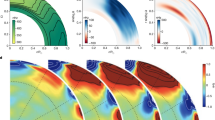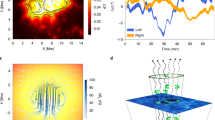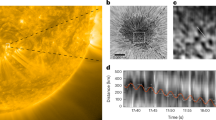Abstract
The observation by Claverie et al.1. of fine structure in the peaks in the power spectrum of low-degree 5-min solar oscillations has been interpreted as being a result of rotational splitting. Claverie et al.1 claim that their measurements imply that an appropriately weighted average Ω̄ of the interior angular velocity Ω(r) of the Sun is about twice the value of Ω at the surface. At first sight their claim looks doubtful, because all 2l + 1 components of the set of modes of degree l appear in the spectrum, whereas only l + 1 of them should be detectable. However, Isaak2 has recently speculated that the additional components are produced by an intense rotating magnetic core, such as had been postulated by Dicke3,4 to account for the 12.2-day periodic component in the Princeton oblateness data5–9. Isaak2 pointed out that the mean period 2π/Ω≃15 days of the solar interior that was inferred from the Birmingham data1 is consistent with a central core rotating with the 12.2-day period and an outer envelope rotating with the photosphere. Moreover, his rough estimate of a few megagauss for the r.m.s. magnetic field that is required to support his conjecture is within about a factor 10 of that required by Dicke3. Thence he concluded that the Birmingham data1 provide the first clear empirical evidence for an intense internal solar magnetic field. Here I examine this evidence in more detail, and show that the conclusion is premature. If the magnetic core does exist, the 5-min oscillations provide no clear evidence that it is rotating rapidly. Furthermore, unless one accepts a contrived magnetic-field configuration, an explanation for the 2l + 1 components of the multiplets is still lacking.
This is a preview of subscription content, access via your institution
Access options
Subscribe to this journal
Receive 51 print issues and online access
$199.00 per year
only $3.90 per issue
Buy this article
- Purchase on SpringerLink
- Instant access to full article PDF
Prices may be subject to local taxes which are calculated during checkout
Similar content being viewed by others
References
Claverie, A., Isaak, G. R., McLeod, C. P. & van der Raay, H. B. Nature 293, 443–445 (1981).
Isaak, G. R. Nature 296, 130–131 (1982).
Dicke, R. H. Proc. Informal Conf. on Status and Future of Solar Neutrino Research Vol. 2 (ed. Friedlander, G.) 109–143 (Brookhaven National Laboratory, Upton, 1978).
Dicke, R. H. New Scient. 83, 12–14 (1979).
Dicke, R. H. & Goldenberg, H. M. Astrophys. J. Suppl. 27, 131–182 (1974).
Dicke, R. H. Phys. Rev. Lett. 37, 1240–1242 (1976).
Dicke, R. H. Solar Phys. 47, 475–515 (1976).
Dicke, R. H. Proc. natn. Acad. Sci. U.S.A. 78, 1309–1312 (1981).
Dicke, R. H. Proc. natn. Acad. Sci. U.S.A. 78, 1989–1993 (1981).
Grec, G., Fossat, E. & Pomerantz, M. Nature 288, 541–544 (1980).
Fossat, E., Grec, G. & Pomerantz, M. Solar Phys. 74, 59–63 (1981).
Deubner, F.-L. Nature 290, 682–683 (1981).
Christensen-Dalsgaard, J. & Gough, D. O. Nature 288, 544–547 (1980).
Christensen-Dalsgaard, J. Proc. 5th Eur. Meet. in Astronomy (ed. Ledoux, P.) A.1.1–A.1.28 (Institut d'Astrophysique, Liège, 1980).
Scuflaire, R., Gabriel, M. & Noels, A. Astr. Astrophys. 99, 39–42 (1981).
Christensen-Dalsgaard, J. & Gough, D. O. Astr. Astrophys. 104, 173–176 (1981).
Christensen-Dalsgaard, J. & Gough, D. O. Mon. Not. R. astr. Soc. 198, 141–171 (1982).
Vandakurov, Yu, V. Astr. Zh. 44, 786–797 (1967).
Gough, D. O. Mon. Not. R. Astr. Soc. 196, 731–745 (1981).
Brookes, J. R., Isaak, G. R. & van der Raay, H. B. Mon. Not. R. astr. Soc. 185, 1–17 (1978).
Scherrer, P. H., Wilcox, J. M., Christensen-Dalsgaard, J. & Gough, D. O. Solar Phys. (in the press).
Ledoux, P. & Simon, R. Ann. Astr. 20, 185–195 (1957).
Goossens, M. Astrophys. Space Sci. 16, 386–404 (1972).
Goossens, M., Smeyers, P. & Denis, J. Astrophys. Space Sci. 39, 257–272 (1976).
Biront, D., Goossens, M., Cousens, A. & Mestel, M. Mon. Not. R. astr. Soc. (in the press).
Mestel, L., Q. Jl R. astr. Soc. 12, 402–416 (1971).
Mestel, L. & Takhar, H. S. Mon. Not. R. astr. Soc. 156, 419–436 (1972).
Mestel, L., Nittman, J., Wood, W. P. & Wright, G. A. E. Mon. Not. R. astr. Soc. 195, 979–1000 (1981).
Dicke, R. H. Solar Phys. 78, 3–16 (1982).
Hill, H. A. et al. Phys. Rev. Lett. 33, 1497–1500 (1974).
Bos, R., Goode, P. R. & Hill, H. A. Phys. Rev. Lett. (submitted).
Gough, D. O. Nature 298, 334–339 (1982).
Author information
Authors and Affiliations
Rights and permissions
About this article
Cite this article
Gough, D. Evidence for an oblique magnetic solar rotator. Nature 298, 350–354 (1982). https://doi.org/10.1038/298350a0
Received:
Accepted:
Issue date:
DOI: https://doi.org/10.1038/298350a0
This article is cited by
-
Is the Sun a Magnet?
Solar Physics (2017)
-
Variation of low-order acoustic solar oscillations over the solar cycle
Nature (1990)
-
Is there an unusual solar core?
Nature (1986)
-
The solar differential rotation: Present status of observations
Solar Physics (1985)
-
Rotational frequency splitting of solar oscillations
Nature (1984)



